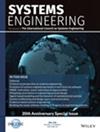工业可执行SysML模型的实用验证
IF 1.6
3区 工程技术
Q4 ENGINEERING, INDUSTRIAL
引用次数: 2
摘要
本文章由计算机程序翻译,如有差异,请以英文原文为准。
Pragmatic verification and validation of industrial executable SysML models
In recent years, Model‐Based Systems Engineering (MBSE) practices have been applied in various industries to design, simulate and verify complex systems. The verification and validation (V&V) of such systems engineering models are crucial to develop high‐quality systems. However, this is a challenging problem due to the complexity of the models and semantic differences in how different tools interpret the models, which can undermine the validity of the obtained results if they go undiscovered. To address these issues, we propose (i) a subset of the SysML language for which the practical semantic integrity of tools can be achieved and (ii) a cloud‐based V&V framework for this subset, lifting verification to an industrial scale. We demonstrate the feasibility of our approach on an industrial‐scale model from the aerospace domain and summarize the lessons learned during transitioning formal verification tools to an industrial context.
求助全文
通过发布文献求助,成功后即可免费获取论文全文。
去求助
来源期刊

Systems Engineering
工程技术-工程:工业
CiteScore
5.10
自引率
20.00%
发文量
0
审稿时长
6 months
期刊介绍:
Systems Engineering is a discipline whose responsibility it is to create and operate technologically enabled systems that satisfy stakeholder needs throughout their life cycle. Systems engineers reduce ambiguity by clearly defining stakeholder needs and customer requirements, they focus creativity by developing a system’s architecture and design and they manage the system’s complexity over time. Considerations taken into account by systems engineers include, among others, quality, cost and schedule, risk and opportunity under uncertainty, manufacturing and realization, performance and safety during operations, training and support, as well as disposal and recycling at the end of life. The journal welcomes original submissions in the field of Systems Engineering as defined above, but also encourages contributions that take an even broader perspective including the design and operation of systems-of-systems, the application of Systems Engineering to enterprises and complex socio-technical systems, the identification, selection and development of systems engineers as well as the evolution of systems and systems-of-systems over their entire lifecycle.
Systems Engineering integrates all the disciplines and specialty groups into a coordinated team effort forming a structured development process that proceeds from concept to realization to operation. Increasingly important topics in Systems Engineering include the role of executable languages and models of systems, the concurrent use of physical and virtual prototyping, as well as the deployment of agile processes. Systems Engineering considers both the business and the technical needs of all stakeholders with the goal of providing a quality product that meets the user needs. Systems Engineering may be applied not only to products and services in the private sector but also to public infrastructures and socio-technical systems whose precise boundaries are often challenging to define.
 求助内容:
求助内容: 应助结果提醒方式:
应助结果提醒方式:


